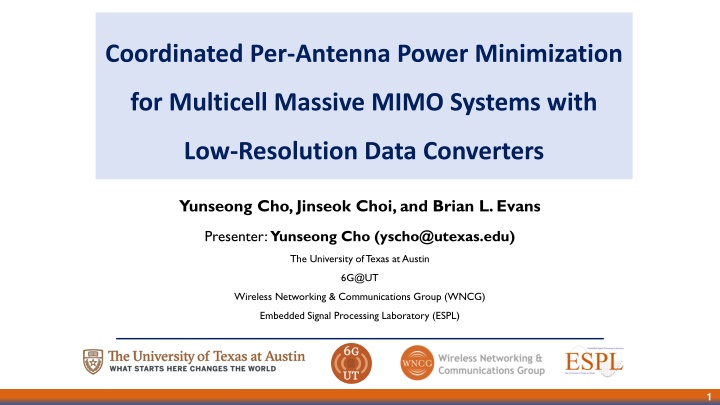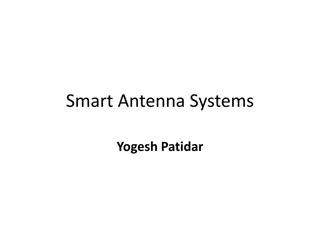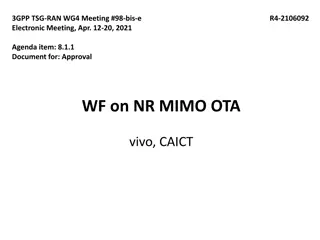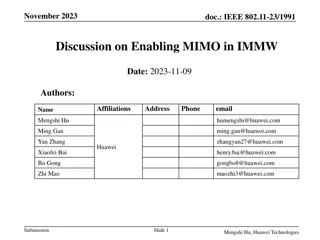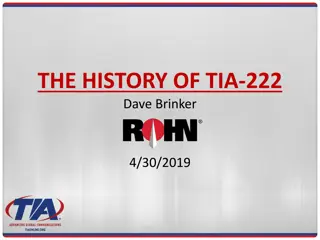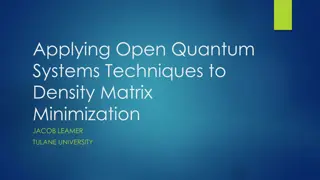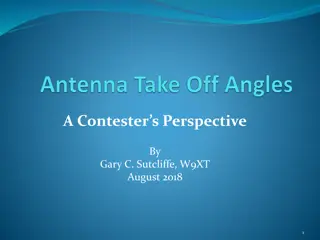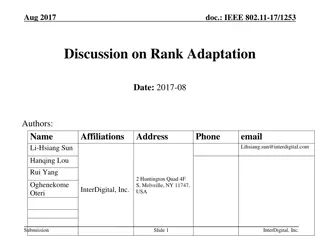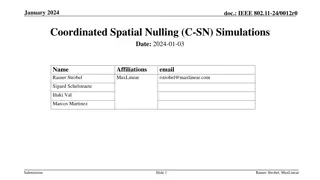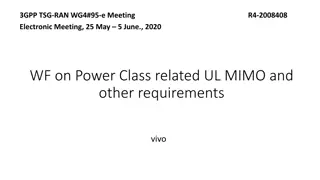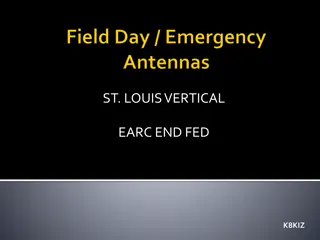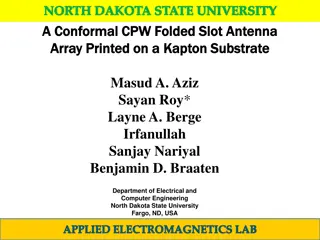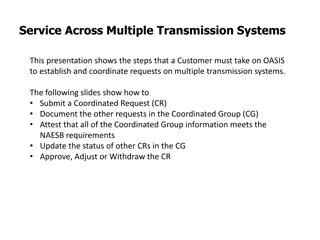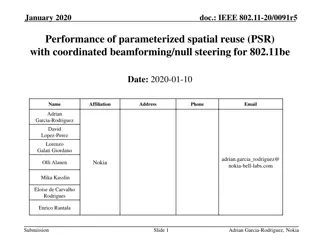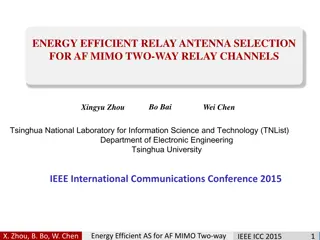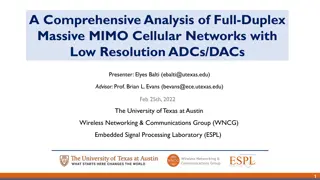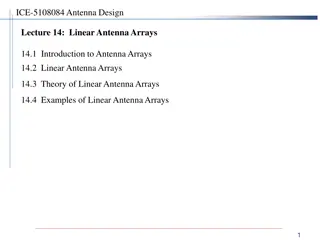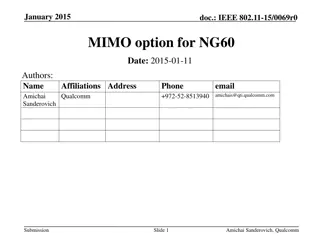Coordinated Per-Antenna Power Minimization for Multicell Massive MIMO Systems with Low-Resolution Data Converters
Massive MIMO systems with low-resolution data converters can achieve significant gains in capacity and spectral efficiency while minimizing power consumption. This study focuses on minimizing transmit power using optimal beamforming solutions for both uplink and downlink channels in a multi-cell, multi-user MIMO OFDM system.
Download Presentation

Please find below an Image/Link to download the presentation.
The content on the website is provided AS IS for your information and personal use only. It may not be sold, licensed, or shared on other websites without obtaining consent from the author.If you encounter any issues during the download, it is possible that the publisher has removed the file from their server.
You are allowed to download the files provided on this website for personal or commercial use, subject to the condition that they are used lawfully. All files are the property of their respective owners.
The content on the website is provided AS IS for your information and personal use only. It may not be sold, licensed, or shared on other websites without obtaining consent from the author.
E N D
Presentation Transcript
Coordinated Per-Antenna Power Minimization for Multicell Massive MIMO Systems with Low-Resolution Data Converters Yunseong Cho, Jinseok Choi, and Brian L. Evans Presenter: Yunseong Cho (yscho@utexas.edu) The University of Texas at Austin 6G@UT Wireless Networking & Communications Group (WNCG) Embedded Signal Processing Laboratory (ESPL) 1
Motivation Massive MIMO Multiple Tx and Rx antennas to exploit multiple propagations # of antennas at base station is scaled up by hundreds. Significant gain in capacity and spectral efficiency, but with high power consumption. Low-power solution Each BS antenna has an RF chain with two high-resolution ADCs or DACs. Power consumption is exponential in the number of quantization bits ( 2?). To reduce power consumption, use low-resolution ADCs and DACs. Per-Antenna Level Constraints Limit antenna powers to achieve energy efficiency and realistic deployment Place less burden on power amplifiers and electronics 2
Problem Statement Goal: Minimize maximum transmit power of quantized DL OFDM with SQINR target Impairments: Quantization noise from low-resolution ADCs and DACs. Thermal noise, intra-cell, and inter-cell interference. Wideband OFDM modulation Solution: Optimal DL beamforming (primal) via optimal UL solution (dual) Use strong duality between our DL and UL. Optimal transmit power for UL with unknown noise covariance. Obtain optimal DL beamforming as function of optimal UL solution. Update noise covariance via projected subgradient ascent algorithm. 3
SYSTEM MODEL Multi-cell Multi-user MIMO OFDM system System model & configuration Multi cell environment (?? cells) Base station has ?? antennas w/ low-res converters Base station serves ?? users w/ single antenna ? subcarriers Time division duplex (TDD) assumption ??,?,?: uplink channel ?th user in ?th cell ?th cell ??,?,? : downlink channel due to TDD assumption ? Quantized received signal in downlink after applying DFT and removing CP needs to be designed: beamforming ??,?? inter-cell interference + inter-user interference quantization gain < 1 4
Problem Formulation Maximum Transmit Power Minimization Uplink (Dual) Maximum Transmit Power Minimization Downlink (Primal) inner minimization outer maximization Upper bound to be minimized ??,?? : uplink power of ?th user in ?th cell at subcarrier ? :noise covariance matrix at ?th base station : SQINR : interference : quantization noise : interference + noise + quantization noise for MMSE ?2: downlink noise power 5
Contribution #1: DL-UL Duality Theorem 1: Duality The virtual uplink problem with MMSE equalizer and unknown noise covariance is equivalent to a Lagrangian dual problem of the downlink problem. Proof: 1. Use MMSE equalizer that maximizes SINR to simplify the constraints. 2. Obtain Lagrangian dual of downlink problem, i.e., ??,?? ;??,?? ,??,? 3. Show that Lagrangian dual of downlink is equivalent to uplink with MMSE equalizer and unknown covariance. . Corollary 1: Strong Duality Strong duality holds between primal downlink and its Lagrangian dual problem Proof: 1. Show that downlink problem (primal) is an instance of second-order cone problem. 2. Show that downlink problemis strictly feasible. 6 6
Contribution #2: Optimal Solution (Uplink Subproblem) inner minimization Corollary 2: Optimal Uplink Solution Optimal transmit power for uplink subproblem for fixed ?? is derived as: is covariance of received signals where ? is diagonal matrix with transmit powers ??,?? , ?,?,?, as its diagonal elements. Proof: 1. Obtain derivative of Lagrangian of downlink problem, i.e., ? ??,?? ; ??,?? ,??,?( ) . ???,?? 2. Set it to zero. 7
Contribution #2: Optimal Solution (Downlink) Corollary 3: Optimal Downlink Solution Optimal downlink beamformer is linearly scaled instance of uplink MMSE equalizer, by solving where is defined as: computed from uplink solution Proof: 1. Assume ??,?? = 2. Plug it to downlink constraints which give system of linear equations as ? = ?2? 1? ??,?? ??,?? , ?,?,?. 8
Contribution #3: Update of Noise Covariance We found optimal solution for both uplink and downlink s However, current solutions are derived for fixed ?? We then update ?? i.e., outer optimization via Projected Subgradient Ascent. s to maximize objective function and satisfy constraints on ??, outer maximization Corollary 4: Subgradient is a subgradient of uplink subproblem in updating ?? Proof: Subproblem is decoupled as which then satisfies ? ?? tr ?? ? ?? ?? We take step in direction of positive subgradient and project ?? onto feasible set, i.e., 9
Proposed Algorithm ? ?+1 Fixed-point algorithm: ??,? ? , ?,?,? are involved in computation of ??,? ? 0 Step 1) Initialize ??,? ? , ?,?,? (?+1) until converges using Step 2) Iteratively update the transmit power ??,? ? + 1 ? ?+1 Step 3) Find uplink MMSE equalizer ??,?? using converged ??,? ? , ?,?,?. Step 4) Compute downlink beamformer ??,?? , ?,?,? based on Corollary 3. Step 5) Repeat the following operations until no update is possible subgradient ascent projection Step 6) Go to Step 2 10
Simulation Results #1: Wideband 16 antennas, 4 cells, 2 users per cell, 32 subcarriers Target SINRs vs. maximum transmit power. Q-CoMP and Q-CoMP-PA does not suffer from divergence, but Q-CoMP-PA has around 3 dBm gain Gap between cases with different ? is marginal. 32 antennas, 4 cells, 2 users per cell, 64 subcarriers, ? = 3, ? = 1 dB Empirical CDF of transmit power of all BS antennas Rightmost point gives maximum transmit power Gap between rightmost and leftmost gives operating range 11
Simulation Results #2: Narrowband 32 antennas, 5 cells, 2 users per cell, 1 subcarrier, ? = 3, ? = 2 dB 32 antennas, 4 cells, 2 users per cell 12
Simulation Results #3: PAPR 32 antennas, 3 cells, 2 users per cell, 64 subcarriers, ? = 3 2.0 dB reduction over Q-CoMP 5.1 dB reduction over Q-Percell 32 antennas, 2 cells, 2 users per cell, ? = 3 0.8 dB reduction over Q-CoMP 1.8 dB reduction over Q-Percell 32 antennas, 4 cells, 2 users per cell, ? = 3 2.0 dB reduction over Q-CoMP 3.4 dB reduction over Q-Percell 13
Conclusion Maximum transmit power minimization problems for downlink Duality Strong Duality We proposed iterative algorithm inspired by strong duality. optimal solution uplink subproblem optimal downlink solution via optimal uplink solution update of covariance matrix via downlink solution using projected subgradient ascend 14
Thank you! 15
